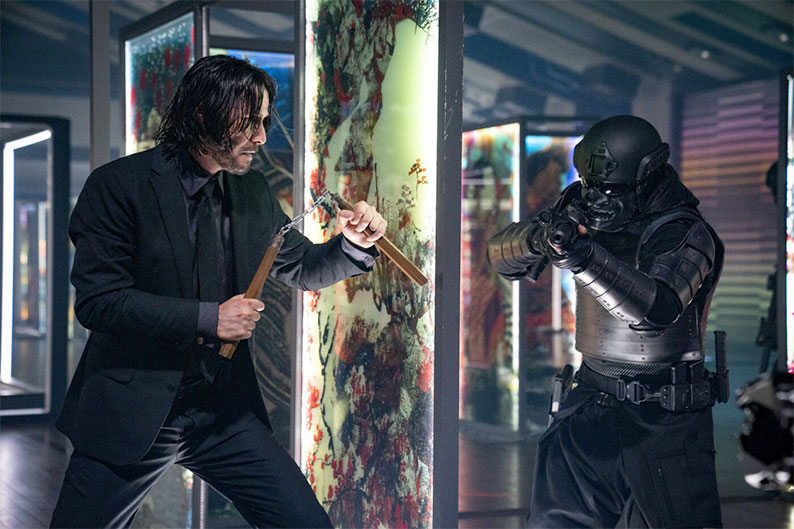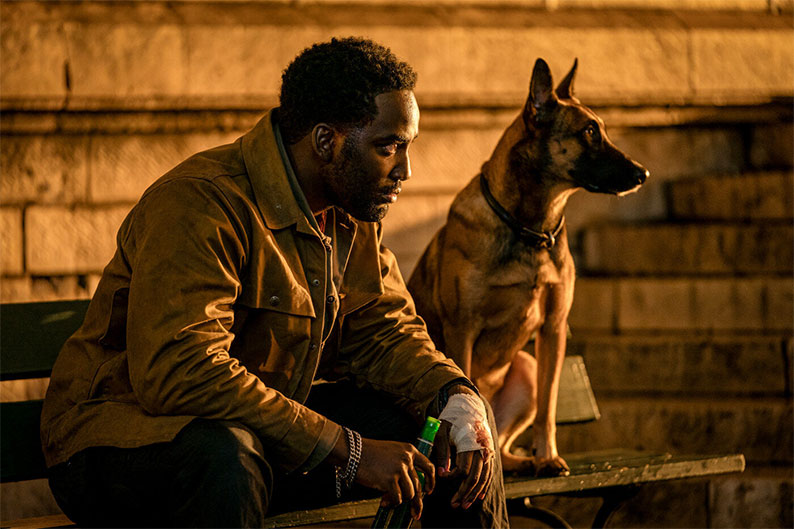| |
“I shot this movie to be seen on IMAX. That’s why you see the anamorphic lenses, the colours, we push the contrast, we push the size, we want you to enjoy the cinema! I’ve tried to go out of my way to make beautiful and interesting characters, so enjoy it. Sit back, eat your popcorn, and if you have to go to the bathroom, go to the bathroom. I’m not on a mission to do a two-and-a-half-hour movie.” |
| |
Director Chad Stahelski** |
I very much wish I could have seen John Wick: Chapter 4 in the cinema because to be frank, for a film in this genre to be this visually sumptuous was actually a rather lovely surprise. As well as each progressive chase or fight upping the action ante, the filmmakers have figured out part of why another action franchise is so attractive to so many. James Bond used to globe trot to give chases and fights a little more visual panache. Wick’s producers have chosen wisely where to set the frankly ludicrous action that the Wick franchise has become famous (and infamous) for. There are visual coups de grace in this film that have no right to be so stately, so noble in the context of a live action cartoon first person shooter assassin film but against the odds (as John almost always is), they simply work. You sort of gape in minimalist wonder at the braggadocio of it. Of course, the cloaking of the very worst behaviour a human being can exhibit with some sort of strict ethical code seems antiquated beyond belief. Abiding by the High Table’s litany of rules and ceremonial clutter seems even more ridiculous taken to this extreme. It’s the very essence of ‘honour among thieves’ or in this case ‘commandments for killers’. It reminds me of something I thought absurd as a child, that a war had rules. While you were busy trying to kill them and they were busy trying to kill you, rules were the last thing people would observe. It was only when I got older, I realised that even in war, the lives of the injured, civilians and aid workers had some official but never binding protection from competing armies. But the man who started a war currently being fought has nothing but contempt for those rules. As the High Table might remind him, “there are consequences…” Let’s hope so.
So why is an audience so sympathetic towards John Wick? We’re on film No. 4. Surely we’ve all got over the puppy’s death by now. Haven’t we? Well, maybe the actor has something to do with it. A YouTuber’s comment beneath 15 minutes of Keanu Reeves’ highlights on The Graham Norton Show (Reeves even curses softly, “Oh my gosh!”) revealed how she’d spotted the actor waiting at an airport. Too nervous to approach him for an autograph, she just casually walked by saying “John, I’m sorry about your dog.” Perfectly in character, Reeves grunted “Thank you,” and then the two of them just burst out laughing. If there is anyone more polite, kinder (the stories are legion, web-wide) and considerate of others out in Hollywood, then I’ll praise them to the skies too. Reeves seems to be just a lovely human being. So does that have anything to do with the fact that we are still gunning for him over four movies as he’s gunning down practically hundreds of people? OK, he’s an actor playing the part of a retired assassin who’s brought back in to the job after his wife dies of cancer and the son of a Russian mafia boss clubs his dog to death, a posthumous gift from his wife. Being a dog lover myself, a small member of a large number of Brits I’d guess, this is the perfect and completely reasonable motive for revenge on an opulent, almost grand guignol scale. But in the first film, John’s just getting started.

There is a line that all the Wick movies inch across and then inch back from again, a sort of cinematic Hokey Cokey. No, it’s not the line of believability or credibility. That was crossed, shot in the head and dumped after the Red Circle club sequence in the first film. No, it’s the related line of audience acceptance. How far can the filmmakers take the character before we start laughing at John rather than with him? Well, John Wick dances so subtly before and over that line, shaking it all about, that if you suspend your disbelief to a professional level, it’s just all there to enjoy. Part of the films’ charm (if charm is the word, charmed to the teeth perhaps) is watching the preposterous action and revelling in how those physical feats are possible because (with some invisible help, no doubt), some poor bastard is falling down those stairs and fighting those fights. If you only could stand to watch credible action, the Wick series may be comedy of the highest order (and the franchise is not short of a belly laugh or two). My moment of choice is in Chapter 3. The knife fight fusillade in the old knife museum (!) in Parabellum is absurdly glorious. The sequence, as does John, takes some beating. In Chapter 4, it’s the Laurel and Hardyesque, endlessly falling down the steps of the Sacre Coeur. It cannot be played for anything other than humour. It happens so many times, its repetition leads it to be laughed at as you would at the same repetitious actions of Sideshow Bob stepping on thirteen rakes over and over in The Simpsons. Is there any point in bringing up how many ribs you’d shatter falling down stone steps over and over again? Naaa. Thought not. This is John Wick!
Does anyone need a breakdown of the plot? In Chapter Four, John is on a mission to bring down the very hierarchy of the High Table itself. We begin with very frightened horse riders being chased by John Wick in the desert. As they would be. After despatching the riders, he faces up to an over-confident Arabic High Table Big Cheese, one perched on the loftiest power rung of the High Table cabal. No spoilers so I’ll just zoom you through the basics. The Marquis Vincent de Gramont is the powerful French agent of the High Table and is a young monster who seems to have everyone’s fate in his own hands. His absurdly expensive sartorial garb tells you a lot and his supercilious bearing and sense of entitlement makes you despise him immediately. Being so young, you do wonder how a man like that ascended to such power. Arriving in New York, he immediately closes down (literally blows it up) the Continental Hotel sending a strong message to John’s former ally, Winston. The Marquis’s mission is to ‘destroy the idea of John Wick’ and like the Operative of the Alliance in Joss Whedon’s Serenity, he kills anyone connected to John. More for self-preservation, the Marquis gets a friend of John’s, Caine – a master assassin and blind by choice - to serve the Table and go after John with a threat to his daughter’s life as a means to pit friend against friend. He also recruits a tracker, a man with a ball-biting dog and a mysterious ability (if it’s explained I didn’t catch it) to know where John is all the time and considering he’s travelling from one side of the world to the other in his attempt to stay ahead, that’s quite a gift. There are several set pieces, each wonderful to behold with perhaps a little too much of similarly staged action. It’s nice to see the shots, both kind, play out without frenetic cutting where Keanu and the stunt team really earn their stripes. But I was at the Osaka Continental so long, I felt I should have at least ordered a few drinks.
The members of the cast are uniformly excellent, all of whom give their all, particularly those charged with performing the action. Keanu Reeves must spend all his free time in a gym or have a deal with the lobster-red, horny guy downstairs. He’s now 58 and performing stunts that would leave most 35 year olds breathless after take one. His very specific physicality, his singular way of moving, precludes the use of a stunt man or a stand in of any kind. He is quite the marvel. Caine, the blind assassin is played by mixed martial arts legend Donnie Yen. His cool is matched by John’s and they share an all-important friendship which is dented along the way but serves them both well before the credits roll. They are very well matched and when on screen together, the film crackles. Yen sits in the shadows during the epic Osaka Continental sequence, quietly eating throughout the mayhem. There is a particularly nice cut to him taking a swallow and then we cut right back into the action. That made me smile. Nice touch, editor Nathan Orloff.

Bill Skarsgård as the Marquis has his moments. He registers emotion with small, nuanced movements, tics almost, and his sadism is unbound. To say he was grossly arrogant would be understating the case. Charon the concierge is again played by the immaculate (and sadly late) Lance Reddick. During his time on Fringe, he convinced me there is no man I know who can wear a shirt quite like him. He died of heart disease in March of this year, the month of John Wick Chapter 4’s release. Ian McShane’s Winston is still frantically strategizing beneath his calm exterior every second. Its his mid-film contact with John that sets up the bloody path to the finish line. I cannot hear about or watch an old fashioned duel without Woody Allen’s Boris’s wonderful exchange in Love and Death with Harold Gould’s Anton whom he has slighted. Anton walks up to Boris and slaps him with his gloves. “Shall we say pistols at dawn?” Boris replies “Well we can say it. I don’t know what it means but we can say it.”
John Wick Chapter 4 delivers on international spectacle, high octane mixed martial arts fighting with added weapons and especially handguns whose ammo clips must be cavernous. The most fanciful aspect of the film is not the absurdity of the indestructible hitman whose bones would be broken, muscles torn and, well, to be honest, all that human body invincibility has all become a bit of a cliché but I thought that silliness had passed its peak in 90s action films. John Wick brings that silliness back in style. You have to accept it to enjoy it. Now, absurdities abound but without doubt, it’s that damn Kevlar suit that stops bullets that always makes me laugh. John protects himself by holding up part of his jacket and the VFX people add a little spark and the sound effects folks add an impact tinkle but it’s still the silliest thing in the John Wick franchise and yet it’s glorious as a way to sustain gun fight action. In fact my favourite moment of the entire film was John having to take his precious armoured suit off near the climax. The tinkle of lead bullet tips dropping onto the marble floor as each garment is stripped away made me so happy. It’s details, little moments like that that gladden the heart.
Apparently there will be a fifth instalment with the rapidly becoming typecast Ana de Armas as the assassin Ballerina and Reeves and McShane reprising their roles in a story set before events in Chapter 4. Hmmm.
Onwards!
|